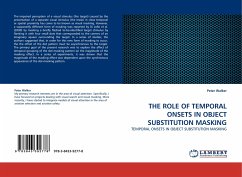
THE ROLE OF TEMPORAL ONSETS IN OBJECT SUBSTITUTION MASKING
TEMPORAL ONSETS IN OBJECT SUBSTITUTION MASKING
Versandkostenfrei!
Versandfertig in 6-10 Tagen
32,99 €
inkl. MwSt.

PAYBACK Punkte
16 °P sammeln!
The impaired perception of a visual stimulus (the target) caused by the presentation of a separate visual stimulus (the mask) in close temporal or spatial proximity has come to be known as visual masking. However, a supposedly different form of masking was reported by Di Lollo et al. (2000) by masking a briefly flashed to-be-identified target stimulus by flanking it with four small dots that corresponded to the corners of an imaginary square surrounding the target. In a series of studies, the authors suggested that, in order for this new form of masking to occur, the the offset of the dot patt...
The impaired perception of a visual stimulus (the target) caused by the presentation of a separate visual stimulus (the mask) in close temporal or spatial proximity has come to be known as visual masking. However, a supposedly different form of masking was reported by Di Lollo et al. (2000) by masking a briefly flashed to-be-identified target stimulus by flanking it with four small dots that corresponded to the corners of an imaginary square surrounding the target. In a series of studies, the authors suggested that, in order for this new form of masking to occur, the the offset of the dot pattern must be asynchronous to the target. The primary goal of the present research was to explore the affect of temporal grouping of the dot masking pattern on the magnitude of the masking effect. In a series of experiments, it was shown that the magnitude of the masking effect was dependent upon the synchronous appearance of the dot-masking pattern.












